
Original Link: https://www.anandtech.com/show/1603
ATI FireGL V5000: Well-Rounded Mid-Range
by Derek Wilson on January 31, 2005 3:52 AM EST- Posted in
- GPUs
Introduction
We recently ran a piece that covered hardware from the three major workstation graphics add-in card vendors (NVIDIA, ATI, and 3DLabs). For background on the hardware we will be testing, please take a look at that article. This piece will focus on the merits of the FireGL V5000 as an addition to ATI's lineup of workstation parts.
That having been said, let us introduce you to the new ATI FireGL V5000:
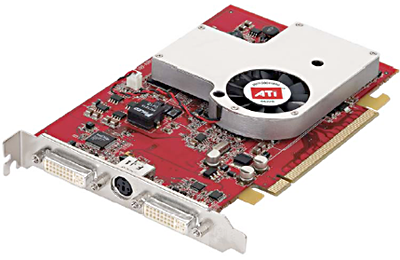
This midrange workstation card is based around a much trimmed down R423 core. The fundamental technology hasn't really changed for a few generations, especially not in terms of workstation feature set. The idea has really been smaller, faster, more. To that end, we've seen ATI focus very much on pushing the hardware and technology they had as hard as possible. To be fair, they did introduce a couple new features with R423 (3Dc being the most interesting), but nothing on the level of the Shader Model 3.0 support NVIDIA had. And the issue here is that the workstation market isn't really going to benefit from a normal map compression scheme. Even 3DLabs supports Pixel Shader 3.0 these days.
ATI can make up ground if they are able to take what they do and do it well. And we've seen them come through here in the consumer space and deliver. Figuratively, not literally: there has been low availability on the most interesting parts. Hopefully for ATI, we'll be to see the same tenacity in the workstation market when it comes to performance with better success on getting product out the door and into the customers' hands.
In talking to ATI about the FireGL V5000, we learned that ATI has recently started trying to push harder into the workstation market and make some headway against the rest of the market. They feel they have started to do so, and we hope that if they actually want the responsibility of a market leader in the workstation segment that they will take on the responsibility of one before they acquire the position. To us, that means we need to see some real hard hitting workstation only features in the next FireGL revision. Overlay planes, quad buffered stereo, and dual-link DVI are great, but there are plenty of professional level OpenGL features that ATI could choose to implement (or to implement better) in the next revision of FireGL.
If ATI really wants to separate themselves and lead the workstation world they can. We would love to see the FireGL team take a stand and demand higher quality for their core. We would love to see IEEE 754 floating point, better anisotropic filtering (and image quality in general), and true virtual memory support from the graphics card to the hard drive that's transparent to software. Of course we're going to want to see at least SM3.0 if not DX10 support coming up soon. Run separate silicon if necessary.
We understand that workstation software sometimes lag the times in terms of technology used. We're not going to see CAD software that pushes pixels like Half-Life 2 anytime soon. But workstation hardware is fundamentally different than consumer level hardware, and a different way of thinking needs to be applied.
Does the FireGL V5000 hint that ATI has what it takes to think about workstation in a way worthy of the leadership position they wish to obtain? Let's take a look and find out.

FireGL V5000 Configuration
The FireGL V5000 brings 2x dual-link DVI and stereo display support to ATI's midrange line, but these are certainly not what we would point out as its strongest features. Effectively taxing the maximum resolution supported by the card costs quite a bit of money and would probably be a better fit for a high end card and workstation.Yes, there are some things we see as being a little mismatched about the FireGL V5000. What is very interesting, however, is that ATI has managed to drop the price of its midrange R423 based FireGL V series by cutting the pixel pipelines, memory bandwidth, and total RAM while maintaining a solid level of workstation performance. This is possible because ATI has maintained the R423 series maximum number of vertex pipelines in the FireGL V5000.
This type of logical thinking about mid range workstation graphics is very refreshing to see from a highly consumer focused company. It doesn't take a lot to realize that a large portion of workstation work is vertex based. Traditionally, professional graphics only corporations have focused on geometry acceleration first, and this shift in thinking from ATI is very fortunate.
Let's look at it this way. For most designers, engineers, or artists who work in programs like AutoCAD, PRO/E, and Maya, most time will be spent working in various wireframe modes. Fill rate and pixel pushing are not of utmost importance in these arenas. In order to focus on drawing lines and points as fast as possible, the hardware fixed function geometry pipeline must be up to snuff. The very pixel focused nature of consumer graphics card design is not exactly a good fit for workstation hardware in this respect. Having the capability to do pixel shading and push high fill rates is good for some workstation applications, these but the CAD/CAM and DCC markets make up a much wider percentage of the user space than all other workstation customers combined.
It is still a necessity to have enough memory bandwidth and pixel power to meet fillrate demands of the applications being run. This should be no problem in wireframe modes at standard resolutions. When we start to push the card with shaded/textured modes and other factors, its limitations will show through.
In the consumer space, ATI is a very good performer. The DirectX and pixel pushing power of the R4xx series is solid. Availability of high end parts has been a tough factor in the race for consumer space dominance on both ends of the spectrum, but on the workstation side, NVIDIA has the advantage. ATI has traditionally been weaker in terms of OpenGL performance (the focus of the workstation market). By stacking the deck in terms of geometry performance, ATI can recover from their OpenGL performance deficit (at least when it comes to the V5000's competition).
In fact, as we will see, depending on the application the price/performance of this ATI part is very good. But if you are a DCC user who likes to run in shaded and textured modes at huge resolutions, this may not be the card for you. We'll let the numbers do the talking in just a second.
Here's a look at how the V5000 stacks up against the other workstation cards we will have in our labs:
| AGP Workstation Graphics Contenders | ||||
| 3Dlabs Wildcat Realizm 200 | ATI FireGL V5000 | ATI FireGL X3-256 | NVIDIA Quadro FX 4000 | |
| Street Price | ~$860 | MSRP $699 | ~$875 | ~$1600 |
| Memory Size/Type | 512MB GDDR3 | 128MB GDDR3 | 256MB GDDR3 | 256MB GDDR3 |
| Memory Bus | 256bit | 128bit | 256bit | 256bit |
| Memory Clock | 500MHz | 432MHz | 450MHz | 500MHz |
| Core Clock | ? | 425MHz | 490MHz | 375MHz |
| Vertex Pipes | 4 | 6 | 6 | 6 |
| Vertex Processing | 36-bit | 32-bit | 32-bit | 32-bit |
| Pixel Pipes | 12 | 8 | 12 | 16 |
| Pixel Processing | 32-bit / 16-bit storage | 24-bit | 24-bit | 32-bit / 16-bit selectable |
| Shader Model Support | VS 2.0 / PS 3.0 | SM 2.0 | SM 2.0 | SM 3.0 |
| 2x Dual-Link DVI | Yes | Yes | Yes | Yes |
| Stereo 3D | Yes | Yes | Yes | Yes |
| Genlock/Framelock | Multiview Upgrade | No | No | SDI version |
The street price of the V5000 will likely be lower than the MSRP of 699, which puts it in a very good position. The V5100 (which we do not have in our labs for testing) has slower clocks than the X3-256 in a PCI Express flavor. It can be found in the low $600 price range while MSRP is $799. Obviously retail and street prices in the workstation market don't work the same as they do on the consumer side.
The Test
This time around, we've used the same configuration we did in our previous workstation article, only we've added a PCI Express system to allow for the FireGL V5000. Unfortunately, we have not yet been able to get our hands on a DP PCI Express based system, so we were forced to go with a single FX-53 in place of the two Opteron 250 setup. We were not able to retest all the cards in a single processor configuration due to time constraints, but we did retest the ATI FireGL X3-256 with the latest driver in a single processor configuration.Fortunately, most of the benchmarks we run cope well without the second processor. We left out obviously skewed tests like the 3DStudio rendering score from the SPECapc benchmark. When focusing on graphics performance tests we did a good job of targeting applications and tests that were impacted by only the GPU.
| Performance Test Configuration | |
| Processor(s): | 2 x AMD Opteron 250 |
| RAM: | 4 x 512MB OCZ PC3200 EL ECC Registered (2 per CPU) |
| Hard Drive(s): | Seagate 120GB 7200RPM IDE (8MB Buffer) |
| Motherboard & IDE Bus Master Drivers: | AMD 8131 APIC Driver NVIDIA nForce 5.10 NVIDIA nForce 6.10 |
| Video Card(s): | ATI FireGL V5000 3Dlabs Wildcat Realizm 200 ATI FireGL X3-256 NVIDIA Quadro FX 4000 HIS Radeon X800 XT Platinum Edition IceQ II Prolink GeForce 6800 Ultra Golden Limited |
| Video Drivers: | 3Dlabs 4.04.0608 Driver ATI FireGL 8.083 Driver NVIDIA Quadro 70.41 (Beta) NVIDIA ForceWare 67.03 (6800U) ATI Catalyst 4.12 (X 800) |
| Operating System(s): | Windows XP Professional SP2 |
| Motherboards: | IWill DK8N v1.0 (AMD-81xx + NVIDIA nForce 3) DFI LANParty UT nF4 Ultra-D (for PCI Express boards) |
| Power Supply: | 600W OCZ Powerstream PSU |
The Kingston RAM was used in the single processor Opteron setup, and the 1024MB sticks of OCZ EB were used in the DFI nF4 Ultra board. The Kingston RAM ran with ECC disabled at 3:3:3:10, while the OCZ memory ran with 2.5:3:3:10 timings.
SPECviewperf 8.0.1 Performance
For our SPECviewperf tests, we will look at graphs of the overall weighted scores for each viewset. We have also listed the scores for the individual tests for each viewset. For each section, we will begin by listing the description of the viewset from the SPEC website.For futher details on how SPECviewperf scores are compiled, please see the SPEC website.
All cards were set to their default professional graphics settings, whatever those happened to be, before running SPECviewperf.
3dsmax Viewset (3dsmax-03)
"The 3dsmax-03 viewset was created from traces of the graphics workload generated by 3ds max 3.1. To ensure a common comparison point, the OpenGL plug-in driver from Discreet was used during tracing.The FireGL V5000 comes very near the performance of the X3-256 under the 3DStudio Max section of the SPECviewperf test. Off to a good start, our suspicion is aroused as to how a slower card with less memory, fewer pixel pipes, and a smaller memory bus could pust such numbers. But it only gets better from here.
The models for this viewset came from the SPECapc 3ds max 3.1 benchmark. Each model was measured with two different lighting models to reflect a range of potential 3ds max users. The high-complexity model uses five to seven positional lights as defined by the SPECapc benchmark and reflects how a high-end user would work with 3ds max. The medium-complexity lighting models use two positional lights, a more common lighting environment.
The viewset is based on a trace of the running application and includes all the state changes found during normal 3ds max operation. Immediate-mode OpenGL calls are used to transfer data to the graphics subsystem."
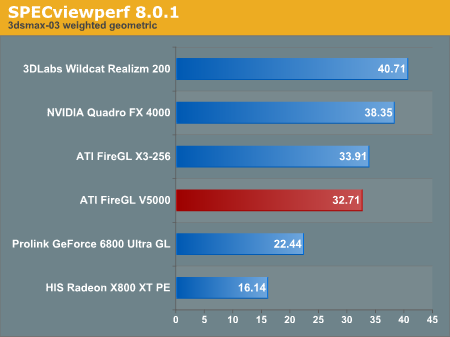
| SPECviewperf 8.0.1 3dsmax-03 | ||||||||||||||
| 1 | 2 | 3 | 4 | 5 | 6 | 7 | 8 | 9 | 10 | 11 | 12 | 13 | 14 | |
| Wildcat Realzim 200 | 38.6 | 38 | 30.2 | 24.3 | 74.1 | 62.1 | 43.5 | 40.4 | 28.3 | 68.7 | 24.1 | 24.1 | 18.3 | 18.3 |
| Quadro 4000 | 38.6 | 38.5 | 21.8 | 18.8 | 75 | 53.7 | 40.6 | 30.6 | 17.2 | 70.3 | 25.3 | 26.2 | 21 | 20.1 |
| FireGL X3-256 | 32.2 | 27.3 | 23.4 | 18.5 | 62.8 | 51 | 28.9 | 31.9 | 18.6 | 66.6 | 20.5 | 20.6 | 16 | 16.1 |
| FireGL V5000 | 33.5 | 23.5 | 24.3 | 15.9 | 65.1 | 43.2 | 24.2 | 31.5 | 15.7 | 66.1 | 22.7 | 21.6 | 18.4 | 14.3 |
| GeForce 6800 U GC | 17.5 | 15.9 | 14.8 | 14.7 | 42.4 | 29.2 | 27.1 | 19.1 | 14.9 | 40.8 | 14.2 | 14.1 | 11.5 | 11.2 |
| Radeon X800 XTPE | 12 | 8.09 | 12.5 | 10.7 | 35.9 | 23.6 | 11.6 | 15.8 | 10 | 32.7 | 11.4 | 6.37 | 9.3 | 7.86 |
CATIA Viewset (catia-01)
"The catia-01 viewset was created from traces of the graphics workload generated by the CATIATM V5R12 application from Dassault Systemes.The V5000 jumps up ahead of the X3-256 here. Both still trail the Realizm 200 and FX 4000. Remember that the V5000 has lower latency unbuffered RAM to deal with, so it may be having an easier time reaching its potential than the cards on the Opteron system.
Three models are measured using various modes in CATIA. Phil Harris of LionHeart Solutions, developer of CATBench2003, supplied SPEC/GPC with the models used to measure the CATIA application. The models are courtesy of CATBench2003 and CATIA Community.
The car model contains more than two million points. SPECviewperf replicates the geometry represented by the smaller engine block and submarine models to increase complexity and decrease frame rates. After replication, these models contain 1.2 million vertices (engine block) and 1.8 million vertices (submarine).
State changes as made by the application are included throughout the rendering of the model, including matrix, material, light and line-stipple changes. All state changes are derived from a trace of the running application. The state changes put considerably more stress on graphics subsystems than the simple geometry dumps found in older SPECviewperf viewsets.
Mirroring the application, draw arrays are used for some tests and immediate mode used for others."
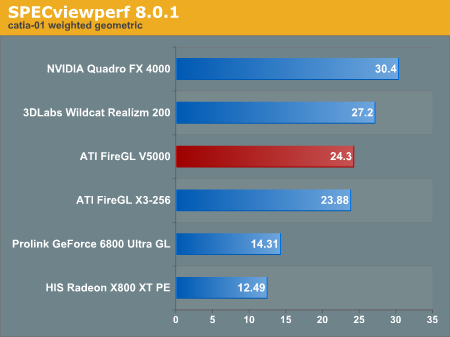
| SPECviewperf 8.0.1 catia-01 | |||||||||||
| 1 | 2 | 3 | 4 | 5 | 6 | 7 | 8 | 9 | 10 | 11 | |
| Quadro 4000 | 48.9 | 37.2 | 26.9 | 27.9 | 19 | 47.8 | 29.6 | 28.9 | 19 | 23.2 | 46.1 |
| Wildcat Realizm 200 | 52.1 | 38.6 | 15.8 | 29.7 | 18.9 | 63.3 | 32.5 | 27.6 | 22 | 20.6 | 13.7 |
| FireGL X3-256 | 39.7 | 25.8 | 19.1 | 22.8 | 16.2 | 34 | 25.2 | 18.8 | 15 | 19.1 | 34.8 |
| FireGL V5000 | 42.6 | 27.6 | 20.8 | 24.1 | 14 | 38.6 | 26.9 | 20.3 | 16.3 | 17.1 | 38.2 |
| GeForce 6800 U GC | 20.2 | 22.5 | 11.5 | 12.6 | 8.9 | 31.1 | 17.2 | 4.49 | 11.2 | 12.7 | 27.2 |
| Radeon X800 XTPE | 20.9 | 10.3 | 10.9 | 11.7 | 7.38 | 26.7 | 13.1 | 12.5 | 8.86 | 7.41 | 21 |
EnSight (ensight-01)
"The ensight-01 viewset replaces the Data Explorer (dx) viewset. It represents engineering and scientific visualization workloads created from traces of CEI's EnSight application.This time around, the ATI FireGL V5000 Trails the X3 by a good margin, but the ATI architecture shows an advantage over the rest of the pack that puts the V5000 in second place.
CEI contributed the models and suggested workloads. Various modes of the EnSight application are tested using both display-list and immediate-mode paths through the OpenGL API. The model data is replicated by SPECviewperf 8.0 to generate 3.2 million vertices per frame.
State changes as made by the application are included throughout the rendering of the model, including matrix, material, light and line-stipple changes. All state changes are derived from a trace of the running application. The state changes put considerably more stress on graphics subsystems than the simple geometry dumps found in older viewsets.
Mirroring the application, both immediate-mode and display-list modes are measured."
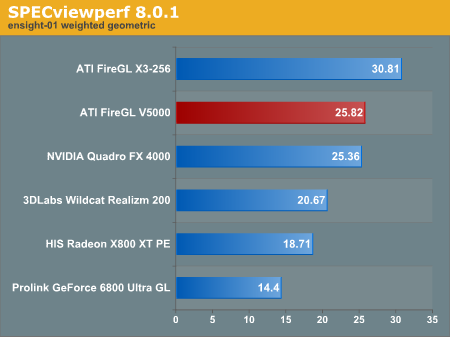
| SPECviewperf 8.0.1 ensight-01 | |||||||||
| 1 | 2 | 3 | 4 | 5 | 6 | 7 | 8 | 9 | |
| Quadro 4000 | 42.7 | 35.4 | 35.6 | 31.1 | 13.7 | 13.6 | 31 | 13.8 | 31 |
| Wildcat Realizm 200 | 24.5 | 20.9 | 26.7 | 23 | 16 | 15.9 | 23 | 16 | 23 |
| FireGL X3-256 | 53.6 | 50 | 53.7 | 44.6 | 12.3 | 12.3 | 44.7 | 12.3 | 44.6 |
| FireGL V5000 | 37.2 | 34.2 | 45.2 | 35.2 | 12 | 12.5 | 35.2 | 12.4 | 35.2 |
| GeForce 6800 U GC | 11.6 | 3.98 | 39.3 | 34.1 | 7.22 | 7.23 | 34 | 7.26 | 34 |
| Radeon X800 XTPE | 14.1 | 54.4 | 45.5 | 34.8 | 5.84 | 5.78 | 34.8 | 5.8 | 34.8 |
Lightscape Viewset (light-07)
"The light-07 viewset was created from traces of the graphics workload generated by the Lightscape Visualization System from Discreet Logic. Lightscape combines proprietary radiosity algorithms with a physically-based lighting interface.Here there's another tie between the ATI FireGL V5000 and the FireGL X3-256. These cards trail the top two by about 8 percent.
The most significant feature of Lightscape is its ability to accurately simulate global illumination effects by pre-calculating the diffuse energy distribution in an environment and storing the lighting distribution as part of the 3D model. The resulting lighting "mesh" can then be rapidly displayed."
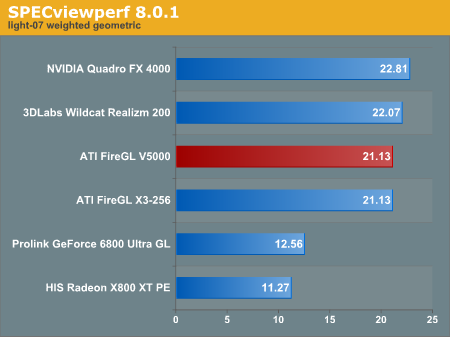
| SPECviewperf 8.0.1 light-07 | |||||
| 1 | 2 | 3 | 4 | 5 | |
| Quadro 4000 | 23.7 | 37.5 | 18.1 | 13.8 | 27.8 |
| Wildcat Realizm 200 | 25.4 | 44.3 | 14.1 | 12.8 | 25.8 |
| FireGL X3-256 | 24.8 | 44.5 | 12.5 | 11.6 | 24.2 |
| FireGL V5000 | 25.2 | 46.9 | 13.5 | 10.3 | 25.6 |
| GeForce 6800 U GC | 13.2 | 24.2 | 9.06 | 6.75 | 16 |
| Radeon X800 XTPE | 12.1 | 22.6 | 7.96 | 5.89 | 14.2 |
Maya Viewset (maya-01)
"The maya-01 viewset was created from traces of the graphics workload generated by the Maya V5 application from Alias.Under Maya, the V5000 surpasses the performance of the X3. This is due to a combination of the fact that the Maya test is very line and point centered and the platform advantages of the platform we tested the V5000 in offer it an advantage.
The models used in the tests were contributed by artists at NVIDIA. Various modes in the Maya application are measured.
State changes as made by the application are included throughout the rendering of the model, including matrix, material, light and line-stipple changes. All state changes are derived from a trace of the running application. The state changes put considerably more stress on graphics subsystems than the simple geometry dumps found in older viewsets.
As in the Maya V5 application, array element is used to transfer data through the OpenGL API."
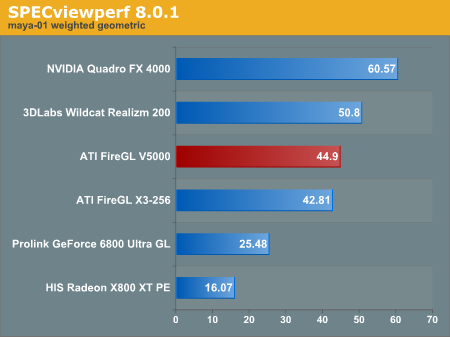
| SPECviewperf 8.0.1 maya-01 | |||||||||
| 1 | 2 | 3 | 4 | 5 | 6 | 7 | 8 | 9 | |
| Quadro 4000 | 152 | 52.5 | 37.2 | 42.6 | 27.6 | 100 | 82.3 | 82.7 | 49.6 |
| Wildcat Realizm 200 | 126 | 41.1 | 30.8 | 33.3 | 17.7 | 96.3 | 79.8 | 76.8 | 44.7 |
| FireGL X3-256 | 110 | 33.3 | 23.2 | 29.2 | 20.6 | 82 | 51.1 | 63.7 | 37.2 |
| FireGL V5000 | 115 | 35.4 | 24.5 | 30.4 | 21.1 | 85.5 | 56.4 | 66.3 | 38.8 |
| GeForce 6800 U GC | 54 | 24.5 | 16 | 12.8 | 10 | 52 | 39.5 | 37.4 | 23.7 |
| Radeon X800 XTPE | 25.2 | 14.9 | 9.02 | 8.03 | 7.2 | 36.1 | 26.7 | 25 | 16.3 |
Pro/ENGINEER (proe-03)
"The proe-03 viewset was created from traces of the graphics workload generated by the Pro/ENGINEER 2001TM application from PTC.Again with the PRO/E test, the V5000 performs exceedingly well. A glance down at the tables will show that the FireGL V5000 is actually the top performer in a couple of the individual tests.
Two models and three rendering modes are measured during the test. PTC contributed the models to SPEC for use in measurement of the Pro/ENGINEER application. The first of the models, the PTC World Car, represents a large-model workload composed of 3.9 to 5.9 million vertices. This model is measured in shaded, hidden-line removal, and wireframe modes. The wireframe workloads are measured both in normal and antialiased mode. The second model is a copier. It is a medium-sized model made up of 485,000 to 1.6 million vertices. Shaded and hidden-line-removal modes were measured for this model.
This viewset includes state changes as made by the application throughout the rendering of the model, including matrix, material, light and line-stipple changes. The PTC World Car shaded frames include more than 100MB of state and vertex information per frame. All state changes are derived from a trace of the running application. The state changes put considerably more stress on graphics subsystems than the simple geometry dumps found in older viewsets.
Mirroring the application, draw arrays are used for the shaded tests and immediate mode is used for the wireframe. The gradient background used by the Pro/E application is also included to model the application workload better."
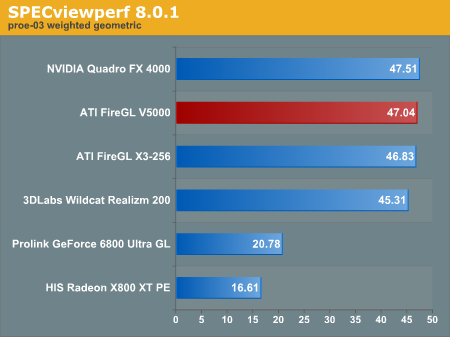
| SPECviewperf 8.0.1 proe-03 | |||||||
| 1 | 2 | 3 | 4 | 5 | 6 | 7 | |
| Quadro 4000 | 26.6 | 31 | 24.9 | 53.4 | 53.2 | 170 | 52.6 |
| Wildcat Realizm 200 | 27.1 | 31.8 | 24.5 | 54.2 | 45.2 | 143 | 51.3 |
| FireGL X3-256 | 38.3 | 45.9 | 31.7 | 38.4 | 36 | 135 | 42.9 |
| FireGL V5000 | 40.4 | 47.2 | 27 | 41.2 | 38.8 | 145 | 45.7 |
| GeForce 6800 U GC | 11.2 | 13.1 | 15.3 | 33.5 | 8.55 | 88.5 | 32.7 |
| Radeon X800 XTPE | 7.33 | 8.63 | 9.05 | 22.7 | 22.5 | 44.2 | 23.8 |
SolidWorks Viewset (sw-01)
"The sw-01 viewset was created from traces of the graphics workload generated by the Solidworks 2004 application from Dassault Systemes.While the V5000 doesn't surpass the X3 this time around, it keeps up rather well with the X3. Solidworks offers quite a few options for texturing and shading that often get used in the real world, this it's fair to say that a part will likely suffer in Solidworks performance a little bit in comparison to a one with more pixel pushing power.
The model and workloads used were contributed by Solidworks as part of the SPECapc for SolidWorks 2004 benchmark.
State changes as made by the application are included throughout the rendering of the model, including matrix, material, light and line-stipple changes. All state changes are derived from a trace of the running application. The state changes put considerably more stress on graphics subsystems than the simple geometry dumps found in older viewsets.
Mirroring the application, draw arrays are used for some tests and immediate mode used for others."
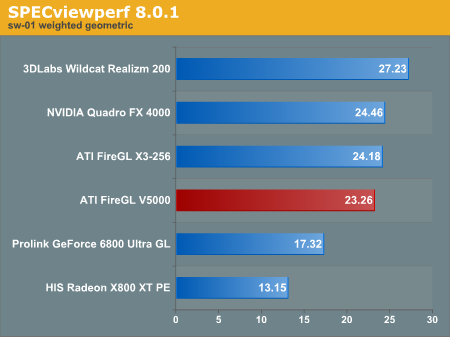
| SPECviewperf 8.0.1 sw-01 | ||||||||
| 1 | 2 | 3 | 4 | 5 | 6 | 7 | 8 | |
| Quadro 4000 | 34.4 | 12.4 | 14.2 | 17.2 | 40.5 | 28.9 | 49.3 | 21.3 |
| Wildcat Realizm 200 | 43.4 | 9.76 | 12.6 | 15.5 | 48 | 32.7 | 103 | 22.6 |
| FireGL X3-256 | 26.6 | 12.1 | 15.3 | 18.5 | 39.5 | 25.5 | 52.4 | 18.2 |
| FireGL V5000 | 30.4 | 13.2 | 12.9 | 15.6 | 36.2 | 24.7 | 60.3 | 19.7 |
| GeForce 6800 U GC | 31.8 | 10.6 | 10.6 | 13.8 | 32.8 | 12.2 | 33.4 | 12.3 |
| Radeon X800 XTPE | 23.7 | 6.04 | 6.37 | 8.04 | 18.3 | 11.5 | 52.1 | 11.1 |
Unigraphics (ugs-04)
"The ugs-04 viewset was created from traces of the graphics workload generated by Unigraphics V17.Again, unigraphics pushes the cards a little harder than other programs with things like its transparency test. This isn't just another wireframe pusher, and that's why we see the V5000 fall a little behind. Of course, for a midrange target, the part still does very well.
The engine model used was taken from the SPECapc for Unigraphics V17 application benchmark. Three rendering modes are measured: shaded, shaded with transparency, and wireframe. The wireframe workloads are measured both in normal and anti-alised mode. All tests are repeated twice, rotating once in the center of the screen and then moving about the frame to measure clipping performance.
The viewset is based on a trace of the running application and includes all the state changes found during normal Unigraphics operation. As with the application, OpenGL display lists are used to transfer data to the graphics subsystem. Thousands of display lists of varying sizes go into generating each frame of the model.
To increase model size and complexity, SPECviewperf 8.0 replicates the model two times more than the previous ugs-03 test."
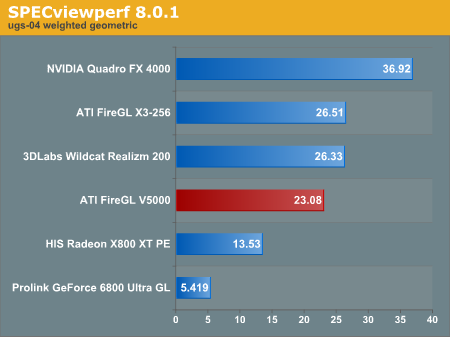
| SPECviewperf 8.0.1 ugs-04 | ||||||||
| 1 | 2 | 3 | 4 | 5 | 6 | 7 | 8 | |
| Quadro 4000 | 30.1 | 34.7 | 27.8 | 31.2 | 51 | 62.2 | 47.5 | 49.8 |
| Wildcat Realizm 200 | 24.3 | 26.8 | 22 | 23.2 | 38.8 | 31.4 | 30.2 | 26.7 |
| FireGL X3-256 | 18.5 | 19.1 | 13.9 | 14.4 | 53.4 | 56.4 | 53.7 | 53.3 |
| FireGL V5000 | 17.8 | 19.6 | 14.5 | 15.7 | 47.5 | 41.5 | 47 | 36.3 |
| GeForce 6800 U GC | 3.29 | 3.86 | 3.01 | 3.52 | 27.3 | 31.9 | 4.94 | 7.38 |
| Radeon X800 XTPE | 11.9 | 12 | 9.13 | 9.13 | 22.2 | 22.6 | 22.2 | 22.4 |
In half of the tests, the FireGL V5000 out performed the FireGL X3-256 under the SPECviewperf 8.0.1 test. In the rest of the suite, the FireGL V5000 wasn't very far behind its competition.
We've seen that the new midrange part can handle itself under synthetic conditions, but how about inside of real applications? Let's take a look at some SPECapc tests to find out.
SPECapc 3DStudio Max 6 SP1 Performance
We ran the 3DStudio Max 6 SP1 Benchmark with both built-in OpenGL drivers and custom OpenGL drivers. We are showing the results of small groups of tests that are very graphics card intensive. The rendering tests are left out in order to keep from skewing the benchmarks in favor of tests run previously on multiprocessor systems.These numbers are very stable when scaling from one to two processors. Total runtime of the tests decreases a lot when moving from one to two processors, which makes these SPECapc numbers (minus the rendering test) good measures of graphics power, but poor judges of overall system performance.
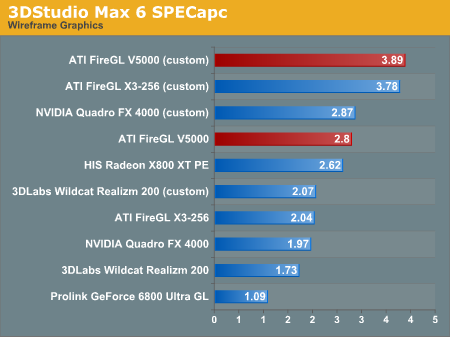
Obviously the the FireGL V5000 offers quite incredible performance in wireframe mode running the ATI 3DStudio Max driver. Both the ATI parts make handy work of the rest of the pack in line drawing under 3dsmax.
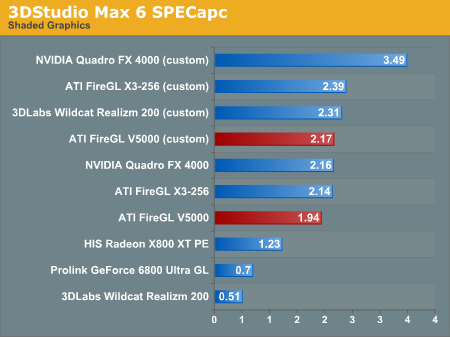
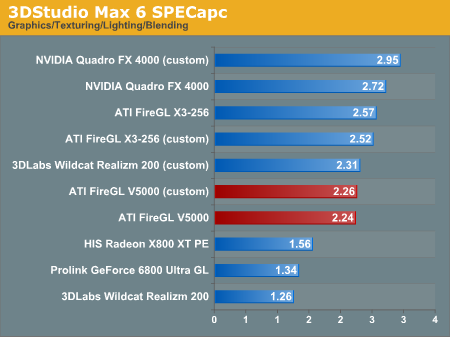
Both shaded and any sort of textured surface performs better on the X3 card, and on the Quadro FX 4000 while we're keeping score. The drop in pixel pipelins didn't help any here.
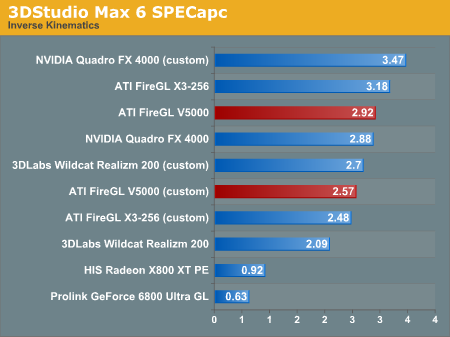
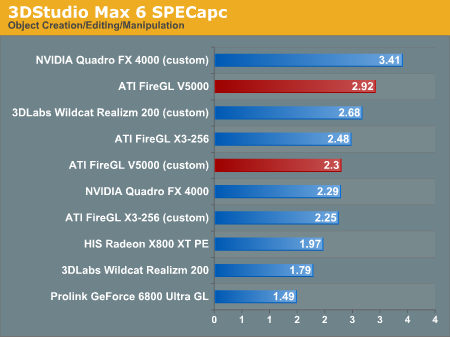
The boost in object creation performance is likely due to the difference in RAM between platforms. Specifically the speed advantage of lower latency unbuffered RAM could help when sendup large blocks of data to the card to draw at a time.
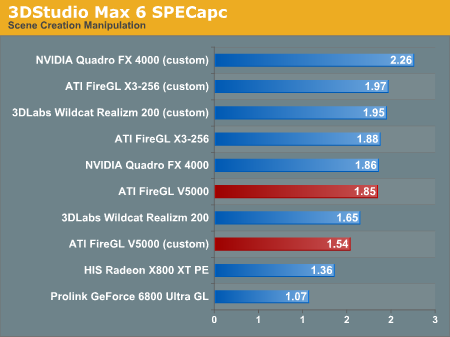
Overall 3dsmas performance under the V5000 is fairly average. However, if you are one of those users who disables shaded mode and goes straight for wireframe drawing, this solution may be a good fit.
SPECapc Maya 5.01 Performance
The ATI FireGL V5000 performed very well in the Maya 5.0 SPECapc, besting even the mighty NVIDIA Quadro FX 4000. Of course, it will be easier to compare parts when we get PCI Express versions of cards in our lab, but no matter what, this is impressive. The fact that the V5000 leads the X3 is a feat, but the fact that it can do it so well consistently is amazing. Granted, this is a very wireframe/mesh centric benchmark, but Maya does still test shaded modes.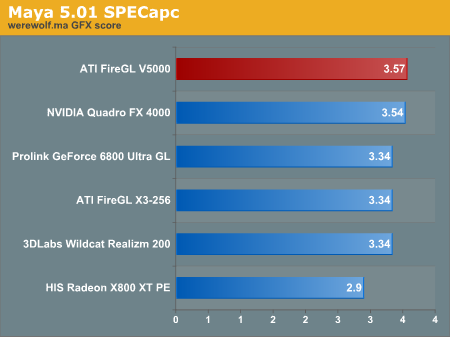
The V5000 makes short work of the werewolf. Followed closely by the Quadro, the midrange ATI card definitely shows some power doing something useful here.
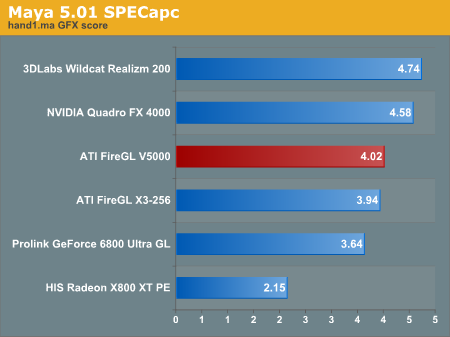
The FireGL may fall behind under the hand test because its such a small quick file that memory bandwidth plays an important role in it's performance. Thus the V5000 is at a disadvantage. There certainly isn't any difficult texturing going on here.
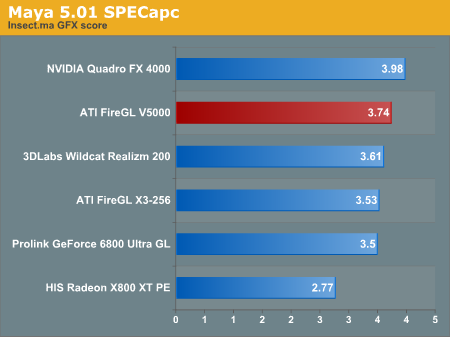
While the insect test has some very large data, much of it is simply moveing points and lines. Thus the V5000 is able to handle the test without falling very far behind the Quadro FX 4000
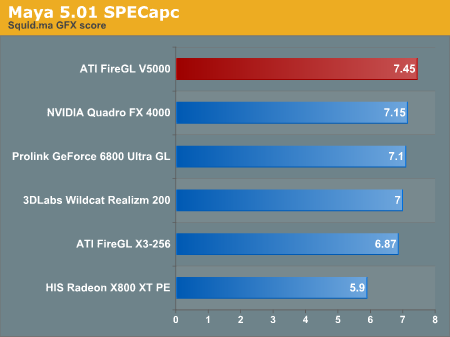
The ATI FireGL V5000 makes pretty handy work of the squid animation. When all is said an done, Maya seems a good fit for the new FireGL V5000.
Pro/ENGINEER Wildfire 2.0 OCUS Performance
The FireGL V5000 did very well on the OCUS benchmark also. Besting the competition's AGP flagship in performance is always cause for some cheer. Of course, the Quadro was running in a DP setup with registered RAM and is tied to a slower bus than PCI Express.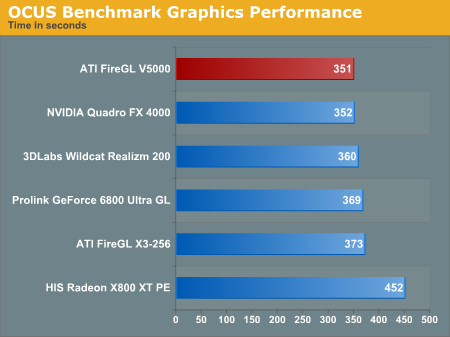
Doom 3 Performance
Under an OpenGL based game, the FireGL V5000 shows a little more than 33% drop in performance over the FireGL X3-256. While we have been looking at applications that have been geometry limited, Doom 3 definitely pushes the pixel side of the equation as well. We can start to see how higher resolutions and more taxing situations could push frame rates ever lower on a card that doesn't have the memory bandwidth and pixel power to keep up with it's geometry pipes.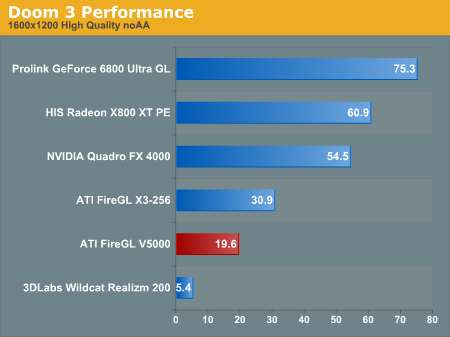
Half-Life 2 Performance
At just under 60% the speed its more powerful sibling hits, the FireGL V5000 shows that even slower midrange workstation cards can still hit comfortably playable framerates under Half-Life 2 at high resolutions.Just to remind everyone, these game tests are here for those in game development looking to multitask cards for DCC and in engine work. This might not be the best card for that based on its general performance characteristics.
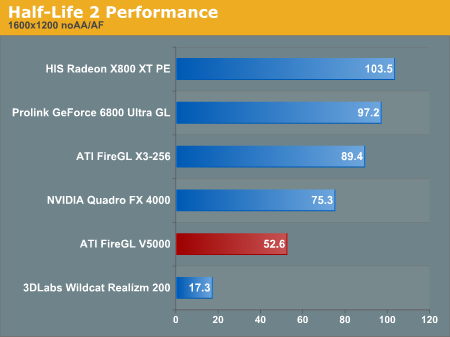
Shader Analysis and Image Quality
We tested the FireGL V5000 with Shadermark v2.1 and added the numbers to the list we compiled previously. Here's what we have now:| Shadermark v2.1 Performance Chart | ||||||
| GeForce 6800U | Quadro FX 4000 | Radeon X850XT | FireGL V5000 | FireGL X3-256 | Realizm 200 | |
| shader 2 | 893 | 596 | 996 | 425 | 731 | 41 |
| shader 3 | 736 | 493 | 735 | 311 | 531 | 28 |
| shader 4 | 737 | 493 | 732 | 311 | 531 | 28 |
| shader 5 | 669 | 448 | 608 | 256 | 438 | 16 |
| shader 6 | 680 | 467 | 735 | 310 | 530 | 28 |
| shader 7 | 631 | 417 | 654 | 282 | 485 | 23 |
| shader 8 | 383 | 255 | 406 | 163 | 301 | 11 |
| shader 9 | 894 | 630 | 1263 | 536 | 977 | 55 |
| shader 10 | 807 | 553 | 819 | 345 | 617 | 43 |
| shader 11 | 680 | 467 | 694 | 291 | 509 | 27 |
| shader 12 | 446 | 319 | 263 | 102 | 186 | 13 |
| shader 13 | 383 | 276 | 361 | 143 | 252 | 13 |
| shader 14 | 446 | 316 | 399 | 161 | 280 | 18 |
| shader 15 | 328 | 244 | 285 | 119 | 206 | 21 |
| shader 16 | 314 | 224 | 336 | 136 | 244 | 8 |
| shader 17 | 425 | 309 | 429 | 180 | 315 | 8 |
| shader 18 | 56 | 39 | 40 | 17 | 30 | 2 |
| shader 19 | 180 | 134 | 139 | 58 | 99 | 6 |
| shader 20 | 57 | 41 | 47 | 19 | 33 | 3 |
| shader 21 | 90 | 63 | - | - | - | - |
| shader 22 | 119 | 96 | 204 | 89 | 154 | 14 |
| shader 23 | 133 | 106 | - | - | - | 15 |
| shader 24 | 80 | 67 | 143 | 63 | 108 | 118 |
| shader 25 | 97 | 69 | 118 | 50 | 86 | 6 |
| shader 26 | 93 | 67 | 123 | 50 | 89 | 6 |
The performance of the V5000 is significantly lower than the X3-256 under HLSL shaders. This is obviously to be expected with memory bandwidth halved, pixel pipes halved, and clock speed lowered.
We still don't have a good GLSL test, but we are working on it for our next workstation graphics card article. ATI GLSL support is still sub par when compared to the rest of the pack.
Here is our previous discussion of the workstation image quality situation. The situation has not yet changed. We will continue to evaluate and test new drivers and hardware from each vendor as it becomes available to us.
For now, we will continue to urge hardware designers to strive for the highest level image quality they can achieve. 3D performance is all about efficiency. But in the workstation market accuracy is of the utmost importance as well.
Final Words
There are plenty of people out there who need a workstation card that's just a workstation card. If all your workstation needs to do is push some wireframe drawings around, this is not a bad part to go with.In fact, the ATI FireGL V5000 is a pretty nifty little card. In a few cases, this mid-range card ends up performing as well or better than an AGP part with more power, RAM, and a memory bus. The factors at work in those cases were a lower latency unbuffered RAM running on a system with newer platform drivers on a bus with bigger bandwidth. Looking at the pure graphics capabilities of the cards, there isn't a way the V5000 should be able to outperform the X3, so the explanation must rely on some other factor. But a benefit of the platform still counts as a benefit of the card.
Based on the numbers the posted here and the enthusiasm ATI had for not crippling the geometry power of their chip, we wouldn't be surprised to see 6 vertex 4 pixel configurations on the budget side in the future. ATI might have some other plans up their sleeves as well.
Currently, ATI holds 81% of the mobile workstation market (what little of one there is), but they see it as a growing segment. The FireGL V5000 might still be a little beefy for all but the largest laptops, but we could see massaging the idea a little bit and giving the mobile engineers some options. ATI was heavily hinting at some upcoming PCI Express mobile workstations that we might be very pleased with if we liked what we saw here.
All in all, the ATI solution is a very solid workstation card for the money if it is implemented in the proper environment. Stick with geometry heavy applications. In fact, if you prefer wireframe only modes, each application we tested ran superbly under the power of the FireGL V5000. PRO/E and Maya generally ran well under the V5000. Enabling things like shading and texturing in 3DStudio may become an issue. The ATI FireGL V5000 allows us to build a box with a midrange workstation card in a highend consumer platform that is able to surpass the performance (in some cases) of a >$5000 DP workstation stacked with the most powerful AGP offering from the competition. Realizing that, we can begin to see the potential of the new FireGL part.
But again, we can't stress enough that workstation applications require a degree of special attention. There are a great deal of enhancements ATI could include in their next generation FireGL but probably won't because it will be tied to their consumer level core. This is the same problem with the way NVIDIA approaches workstation graphics. Granted, they can both push huge frame rates, and geometry processing (while secondary) is still very fast.
The fact that ATI is willing to take a step back and evaluate the way they are looking at things like the geometry pipelines in their workstation parts gives us hope for the future. Here's to continued execution of ideas that make a whole lot of common sense.







